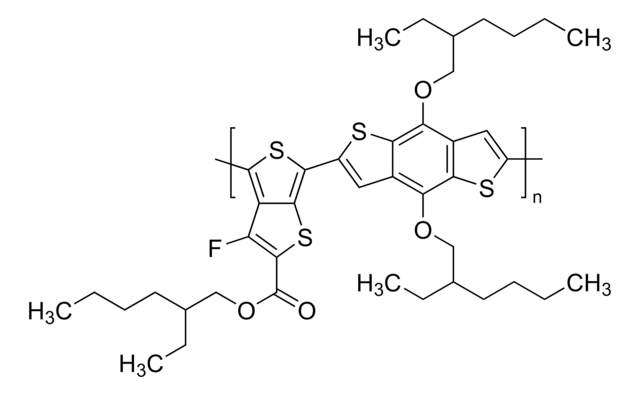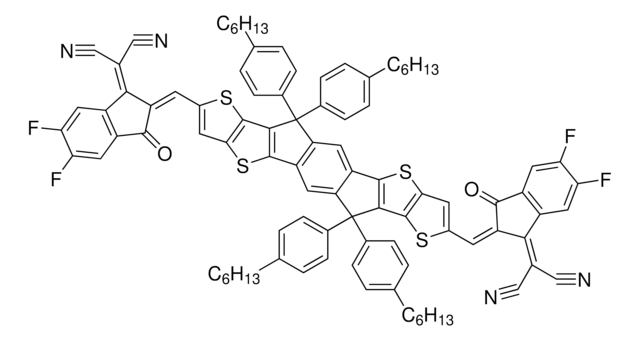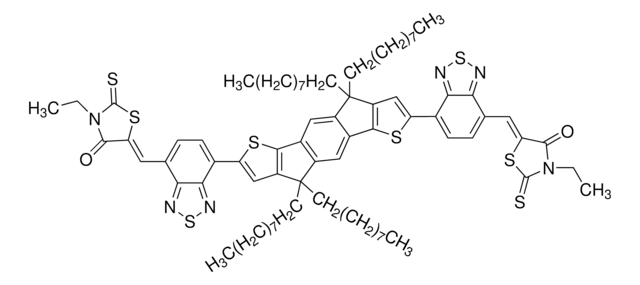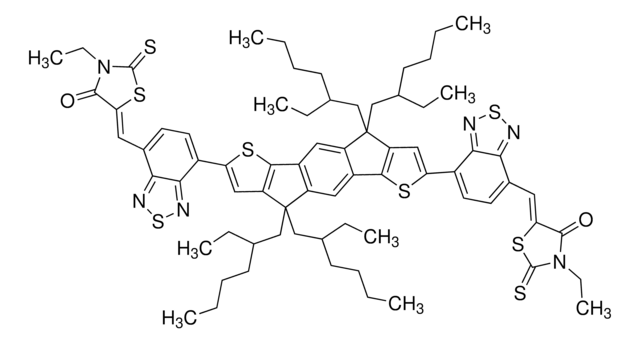906336
PBDB-T-2F
Synonyme(s) :
PCE135, PM6, Poly[[4,8-bis[5-(2-ethylhexyl)-4-fluoro-2-thienyl]benzo[1,2-b:4,5-b′]dithiophene-2,6-diyl]-2,5-thiophenediyl[5,7-bis(2-ethylhexyl)-4,8-dioxo-4H,8H-benzo[1,2-c:4,5-c′]dithiophene-1,3-diyl]-2,5-thiophenediyl]
About This Item
Produits recommandés
Description
Band gap: 1.9 eV
Forme
particles
Poids mol.
Mw 80,000-200,000 g/mol by GPC
Couleur
Fine
Solubilité
chlorobenzene: soluble
chloroform: soluble
dichlorobenzene: soluble
Énergie orbitale
HOMO -5.5 eV
LUMO -3.6 eV
PDI
2‑4
Catégories apparentées
Application
Polymeric donor material
LUMO=−3.6 eV
HOMO=−5.5 eV
OPV Device Performance:
PBDB-T-2F: ITIC-F (1:1 w/w)
Voc= 0.84V
Jsc= 22.2 mA/cm2
FF= 0.725
PCE=13.5%
PBDB-T-2F (or PM6) is a wide bandgap polymer donor (n-type semiconductor) containing fluorinated thienyl benzodithiophene (BDT-2F) used in high performance polymer solar cells (PSCs). PBDB-T-2F possesses high crystallinity and strong π-π stacking alignment, which are favourable to charge carrier transport and hence suppress recombination in devices. PBDBT-2F based PSCs were reported to have thickness and area insensitive performance and is a promising candidate for large-scale roll-to-roll manufacturing of high-efficiency polymer solar cells.
For example, recently, new study have shown PBDB-T-2F:IT-4F(Sigma Aldrich Cat. No. 901423) based PSCs yielded an impressive PCE of 13.5% due to the synergistic effect of fluorination on both donor and acceptor, which is among the highest values recorded in the literatures for PSCs to date [1]. The PBDB-T-2F:IT-4F baed PSCs also showed good storage, thermal and illumination stabilities with respect to the efficiency. High efficiency of >11% was maintained for a wide range of film area and thickness. When paired with selenopheno[3,2-b]thiophene-based narrow-bandgap non-fullerene acceptor, an impressive efficiency of 13.3 % was obtained with thickness-insensitive feature.
It has also been previously reported, PBDB-T-2F when paired with narrow band-gap small molecule acceptor 2,2′-((2Z,2′Z)-((4,4,9,9-tetrahexyl-4,9-dihydro-s-indaceno[1,2-b:5,6-b′]dithiophene-2,7-diyl)bis(methanylylidene))bis(3-oxo-2,3-dihydro-1H-indene-2,1-diylidene))dimalononitrile (IDIC), the as-cast film (without extra treatments) showed an outstanding power conversion efficiency (PCE) of 11.9%, a record value for as-cast polymer solar cells. Moreover, the performance of PBDB-T-2F:IDIC based devices is insensitive to the active layer thickness (≅95-255 nm) and device area (0.20-0.81 cm2), and thus is a promising candidate for future roll-to-roll mass manufacturing and practical application of highly efficient PSCs.
It has also been reported, PBDB-T-2F possesses a strong absorption in the short wavelength region of 300-685 nm with a large bandgap of 1.80 eV, which is complementary to that of ITIC (1.55 eV) and facilitates achieving high short-circuit current (Jsc) in PSCs. Moreover, PBDB-T-2F shows a deep HOMO level of −5.50 eV, a strong crystallinity and a dominant face on packing, which helps to achieve a high open-circuit voltage (Voc) and fill factor (FF) in PSCs.
Code de la classe de stockage
11 - Combustible Solids
Classe de danger pour l'eau (WGK)
WGK 3
Point d'éclair (°F)
Not applicable
Point d'éclair (°C)
Not applicable
Certificats d'analyse (COA)
Recherchez un Certificats d'analyse (COA) en saisissant le numéro de lot du produit. Les numéros de lot figurent sur l'étiquette du produit après les mots "Lot" ou "Batch".
Déjà en possession de ce produit ?
Retrouvez la documentation relative aux produits que vous avez récemment achetés dans la Bibliothèque de documents.
Les clients ont également consulté
Articles
To achieve net-zero emissions by 2050, renewable power contributions must triple. Photovoltaic stations provide vital utility power, achieved primarily through third- and fourth-generation technology. Promising trends include recycling and revolutionary, ultra-lightweight, flexible, and printable solar cells.
Professor Chen (Nankai University, China) and his team explain the strategies behind their recent record-breaking organic solar cells, reaching a power conversion efficiency of 17.3%.
Notre équipe de scientifiques dispose d'une expérience dans tous les secteurs de la recherche, notamment en sciences de la vie, science des matériaux, synthèse chimique, chromatographie, analyse et dans de nombreux autres domaines..
Contacter notre Service technique



![[6,6]-Phenyl C71 butyric acid methyl ester 99%](/deepweb/assets/sigmaaldrich/product/structures/716/624/9fb9f2f0-ae99-429f-8d3a-b12267976a4d/640/9fb9f2f0-ae99-429f-8d3a-b12267976a4d.png)






![[6,6]-Phenyl C61 butyric acid methyl ester >99.9%](/deepweb/assets/sigmaaldrich/product/structures/359/221/d990c746-0960-4c69-bf76-fe09b193824d/640/d990c746-0960-4c69-bf76-fe09b193824d.png)